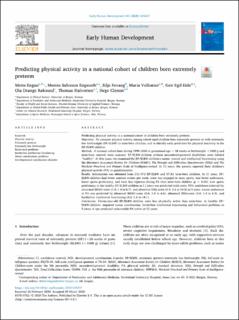| dc.contributor.author | Engan, Mette | |
| dc.contributor.author | Engeseth, Merete Salveson | |
| dc.contributor.author | Fevang, Silje Katrine Elgen | |
| dc.contributor.author | Vollsæter, Maria | |
| dc.contributor.author | Eide, Geir Egil | |
| dc.contributor.author | Røksund, Ola Drange | |
| dc.contributor.author | Halvorsen, Thomas | |
| dc.contributor.author | Clemm, Hege Havstad | |
| dc.date.accessioned | 2021-03-22T12:37:59Z | |
| dc.date.available | 2021-03-22T12:37:59Z | |
| dc.date.created | 2020-11-03T17:36:54Z | |
| dc.date.issued | 2020 | |
| dc.identifier.citation | Engan, M., Engeseth, M. S., Fevang, S., Vollsæter, M., Eide, G. E., Røksund, O. D., Halvorsen, T., & Clemm, H. (2020). Predicting physical activity in a national cohort of children born extremely preterm. Early Human Development, 145. | en_US |
| dc.identifier.issn | 0378-3782 | |
| dc.identifier.uri | https://hdl.handle.net/11250/2734835 | |
| dc.description.abstract | Predicting physical activity in a national cohort of children born extremely preterm.
Objectives
To compare physical activity among school-aged children born extremely preterm or with extremely low birthweight (EP/ELBW) to term-born children, and to identify early predictors for physical inactivity in the EP/ELBW-children.
Methods
A national cohort born during 1999–2000 at gestational age < 28 weeks or birthweight <1000 g and term-born controls were assessed. EP/ELBW-children without neurodevelopmental disabilities were labeled “healthy”. At five years, we examined the EP/ELBW-children's motor, mental and intellectual functioning using the Movement Assessment Battery for Children (MABC), The Strength and Difficulties Questionnaire (SDQ) and The Wechsler Preschool and Primary Scale of Intelligence-revised. At 11 years, the parents reported their children's physical activity (PA) in questionnaires.
Results
Information was obtained from 231/372 EP/ELBW and 57/61 term-born children. At 11 years, EP/ELBW-children had fewer exercise events per week, were less engaged in team sports, had lower endurance, lower sports proficiency, and were less vigorous during PA than term-born children (p < 0.05). Low sports proficiency in the healthy EP/ELBW-children at 11 years was predicted (odds ratio; 95% confidence interval) by abnormal MABC-score (3.0; 1.0 to 8.7), and abnormal SDQ-score (4.0; 1.6 to 10.0) at 5 years. Lower endurance at PA was predicted by abnormal MABC-score (2.6; 1.0 to 6.6), abnormal SDQ-score (3.0; 1.4 to 6.5), and borderline intellectual functioning (4.2; 1.8 to 10.1).
Conclusions
Eleven-year-old EP/ELBW-children were less physically active than term-born. In healthy EP/ELBW-children, impaired motor coordination, borderline intellectual functioning and behavioral problems at 5 years of age predicted unfavorable PA habits at 11 years. | en_US |
| dc.language.iso | eng | en_US |
| dc.publisher | Elsevier | en_US |
| dc.rights | Navngivelse 4.0 Internasjonal | * |
| dc.rights.uri | http://creativecommons.org/licenses/by/4.0/deed.no | * |
| dc.subject | physical activity | en_US |
| dc.subject | extremely preterm | en_US |
| dc.subject | extremely low birthweight | en_US |
| dc.subject | behavioral problems | en_US |
| dc.subject | borderline intellectual functioning | en_US |
| dc.subject | motor coordination problems | en_US |
| dc.subject | developmental coordination disorder | en_US |
| dc.title | Predicting physical activity in a national cohort of children born extremely preterm | en_US |
| dc.type | Peer reviewed | en_US |
| dc.type | Journal article | en_US |
| dc.description.version | publishedVersion | en_US |
| dc.rights.holder | © 2020 The Authors | en_US |
| dc.source.pagenumber | 1-8 | en_US |
| dc.source.volume | 145 | en_US |
| dc.source.journal | Early Human Development | en_US |
| dc.identifier.doi | 10.1016/j.earlhumdev.2020.105037 | |
| dc.identifier.cristin | 1844661 | |
| dc.source.articlenumber | 105037 | en_US |
| cristin.ispublished | true | |
| cristin.fulltext | original | |
| cristin.qualitycode | 1 | |

